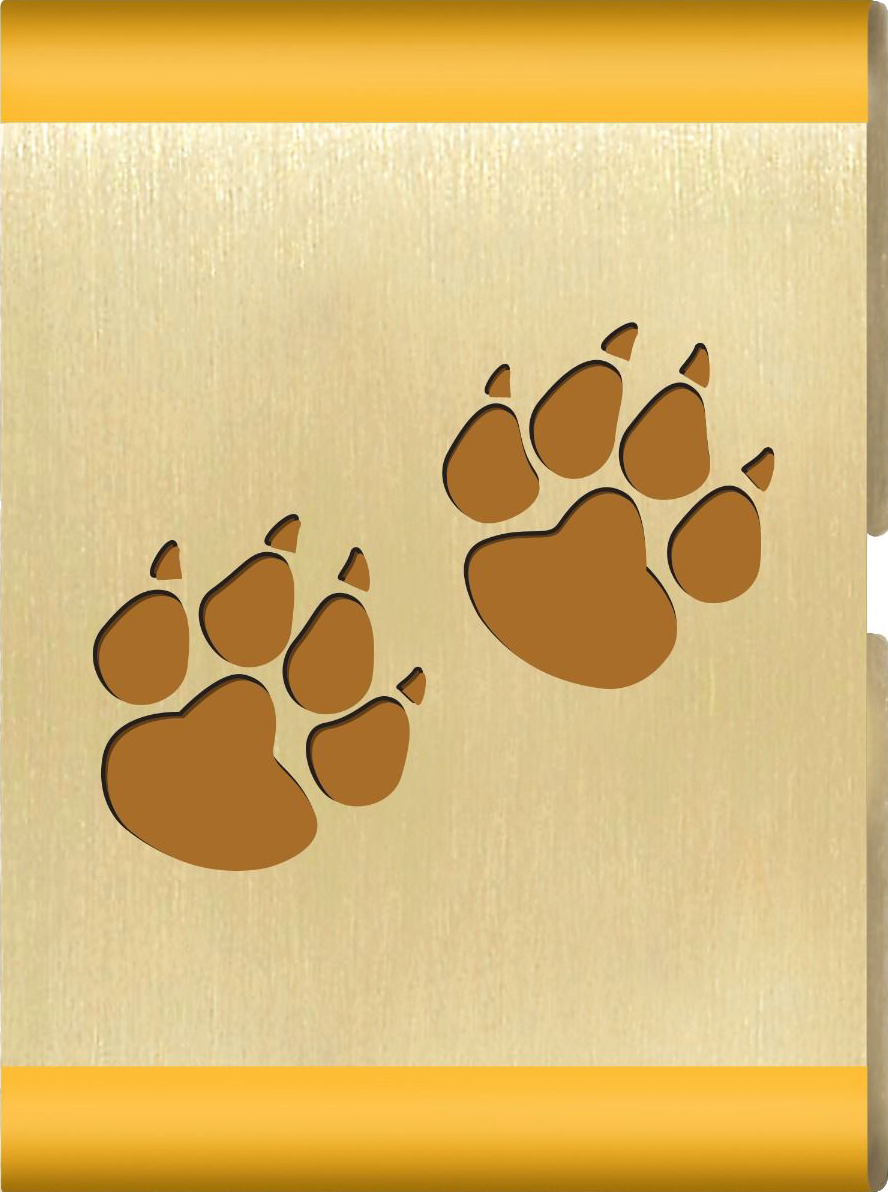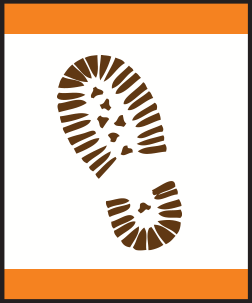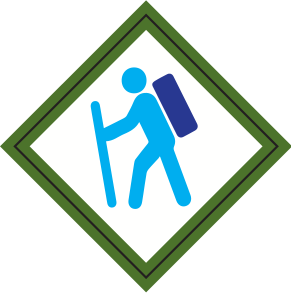Adventure
|
Area
|
Rank
|
Type
|
Requirements*
|
Mountain Lion (.pdf, docx)
 |
Hike |
 |
Required |
| 1. |
Gather the outdoor items you need to have with you when you go on an outdoor adventure, and understand how they are used. Also understand and commit to practicing the buddy system. |
| 2. |
Learn what SAW (Stay, Answer, Whistle) means. Demonstrate what you can do to stay safe if you become separated from the group when you are outdoors. |
| 3. |
Demonstrate an understanding of respect for animals and nature when participating in a learning hike. |
|
Ready, Set, Grow
(.pdf, .docx)
 |
Plants |
 |
Elective |
| 1. |
Visit with an individual who can demonstrate different ways to garden and the basic skills needed to garden. |
| 2. |
Learn where the food we eat comes from. |
| 3. |
Plant a small container garden. |
|
My Tiger / Backyard Jungle
 |
Plants / Hike / Nature |
 |
Elective |
| 1. |
With your parent/guardian or other caring adult (referred to in the handbook as "your adult partner"), go for a walk outside, and pick out two or more sights or sounds of "nature" around you. Discuss with your partner or den. |
| 2. |
Take a 1-foot hike. Make a list of the living things you find on your 1-foot hike. Discuss these plants or animals with your parent/guardian, other caring adult, or your den. |
| 3. |
Point out two different kinds of birds that live in your area. With your parent/guardian, other caring adult, or den, find out more about one of these birds. |
| 4. |
Be helpful to nature by planting a plant, shrub, or tree. Learn more about the needs and growth of the item you've planted. |
| 5. |
Build and hang a birdhouse. |
|
Tigers in the Wild
 |
Plants / Hike / Nature |
 |
Required |
| 1. |
With your parent, guardian, or other caring adult, name and collect the Cub Scout Six Essentials you need for a hike. Tell your den leader what you would need to add to your list to prepare for rain. |
| 2. |
Go for a short hike with your den or family, and carry your own gear. Show you know how to get ready for this hike. |
| 3. |
Do the following: |
| |
A. |
Listen while your leader reads the Outdoor Code. Talk about how you can be clean in your outdoor manners. |
| |
B. |
Listen while your leader reads the Leave No Trace Principles for Kids. Discuss why you should “Trash Your Trash.” |
| |
C. |
Apply the Outdoor Code and Leave No Trace Principles for Kids on your Tiger den and pack outings. After one outing, share what you did to demonstrate the principles you discussed. |
| 4. |
While on the hike, find three different kinds of plants, animals, or signs that animals have been on the trail. List what you saw in your Tiger Handbook. |
| 5. |
Participate in an outdoor pack meeting or pack campfire. Sing a song or act out a skit with your Tiger den as part of the program. |
| 6. |
Find two different trees and two different types of plants that grow in your area. Write their names in your Tiger Handbook. |
| 7. |
Visit a nature center, zoo, or another outside place with your family or den. Learn more about two animals, and write down two interesting things about them in your Tiger Handbook. |
|
Paws on the Path
 |
Animals - Birds / Hke |
 |
Required |
| 1. |
Show you are prepared to hike safely in any outdoor setting by putting together the Cub Scout Six Essentials to take along on your hike. |
| 2. |
Tell what the buddy system is and why we always use it in Cub Scouting. Describe what you should do if you get separated from your group while hiking. |
| 3. |
Choose the appropriate clothing to wear on your hike based on the expected weather. |
| 4. |
Before hiking, recite the Outdoor Code and the Leave No Trace Principles for Kids with your leader. (This may be combined with requirement 3 of the Call of the Wild adventure.) After hiking, discuss how you showed respect for wildlife. |
| 5. |
Go on a 1-mile hike with your den or family. Find two interesting things that you’ve never seen before and discuss with your den or family. |
| 6. |
Name two birds, two insects, and/or two other animals that live in your area. Explain how you identified them. |
| 7. |
Draw a map of an area near where you live using common map symbols. Show which direction is north on your map. |
|
Fun, Feathers and Ferns
 |
Animals / Hike / Plants / Nature |
 |
Required |
| Complete Requirement 1 and three others. |
| 1. |
While hiking or walking for one mile, identify six signs that any mammals, birds, insects, reptiles, or plants are living near the place where you choose to hike or walk. |
| 2. |
Visit one of the following: zoo, wildlife refuge, nature center, aviary, game preserve, local conservation area, wildlife rescue group, or fish hatchery. Describe what you learned during your visit. |
| 3. |
Name one animal that has become extinct in the last 100 years and one animal that is currently endangered. Explain what caused their declines. |
| 4. |
Observe wildlife from a distance. Describe what you saw. |
| 5. |
Use a magnifying glass to examine plants more closely. Describe what you saw through the magnifying glass that you could not see without it. |
| 6. |
Learn about composting and how vegetable waste can be turned into fertilizer for plants. |
| 7. |
Plant a vegetable or herb garden. |
|
A Bear Goes Fishing
 |
Animals - Fish |
 |
Elective |
| Complete at least three of the following. |
| 1. |
Discover and learn about three types of fish in your area. Draw a color picture of each fish, record what each one likes to eat, and describe what sort of habitat each one likes. |
| 2. |
Learn about your local fishing regulations with your den leader or a parent or guardian. List three of the regulations you learn about and one reason each regulation exists. |
| 3. |
Learn about fishing equipment, and make a simple fishing pole. Practice casting at a target. |
| 4. |
Go on a fishing adventure, and spend a minimum of one hour trying to catch a fish. Put into practice the things you have learned about fish and fishing equipment. |
|
Webelos Walkabout
 |
Hike / Plants |
 |
Required |
| 1. |
Plan a hike or outdoor activity. |
| 2. |
Assemble a first-aid kit suitable for your hike or activity. |
| 3. |
Recite the Outdoor Code and the Leave No Trace Principles for Kids from memory. Talk about how you can demonstrate them on your Webelos adventures. |
| 4. |
With your Webelos den or with a family member, hike 3 miles. Before your hike, plan and prepare a nutritious lunch or snack. Enjoy it on your hike, and clean up afterward. |
| 5. |
Describe and identify from photos any poisonous plants and dangerous animals and insects you might encounter on your hike or activity. |
| 6. |
Perform one of the following leadership roles during your hike: trail leader, first-aid leader, or lunch or snack leader. |
|
Into the Wild
 |
Animals |
  |
Elective |
| 1. |
Collect and care for an “insect, amphibian, or reptile zoo.” You might have crickets, ants, grasshoppers, a lizard, or a toad (but be careful not to collect or move endangered species protected by federal or state law). Study them for a while and then let them go. Share your experience with your Webelos den. |
| 2. |
Set up an aquarium or terrarium. Keep it for at least a month. Share your experience with your Webelos den by showing them photos or drawings of your project or by having them visit to see your project. |
| 3. |
Watch for birds in your yard, neighborhood, or area for one week. Identify the birds you see, and write down where and when you saw them. |
| 4. |
Learn about the bird flyways closest to your home. Find out which birds use these flyways. |
| 5. |
Watch at least four wild creatures (reptiles, amphibians, arachnids, fish, insects, or mammals) in the wild. Describe the kind of place (forest, field, marsh, yard, or park) where you saw them. Tell what they were doing. |
| 6. |
Identify an insect, reptile, bird, or other wild animal that is found only in your area of the country. Tell why it survives in your area. |
| 7. |
Give examples of at least two of the following: |
| |
A. |
A producer, a consumer, and a decomposer in the food chain of an ecosystem |
| |
B. |
One way humans have changed the balance of nature |
| |
C. |
How you can help protect the balance of nature |
| 8. |
Learn about aquatic ecosystems and wetlands in your area. Talk with your Webelos den leader or family about the important role aquatic ecosystems and wetlands play in supporting life cycles of wildlife and humans, and list three ways you can help. Resources: Wetlands. Wildlife fact sheets, Houston Ecoregions: (Coastal Marshes, Gulf of Mexico, Estuaries and Bays), Maps of Houston Wetlands |
| 9. |
Do one of the following: |
| |
A. |
Visit a museum of natural history, a nature center, or a zoo with your family, Webelos den, or pack. Tell what you saw. |
| |
B. |
Create a video of a wild creature doing something interesting, and share it with your family and den. |
|
|
Into the Woods
 |
Plants |
  |
Elective (DC) |
| 1. |
Identify two different groups of trees and the parts of a tree. |
| 2. |
Identify four trees common to the area where you live. Tell whether they are native to your area. Tell how both wildlife and humans use them. |
| 3. |
Identify four plants common to the area where you live. Tell which animals use them and for what purpose. |
| 4. |
Develop a plan to care for and then plant at least one plant or tree, either indoors in a pot or outdoors. Tell how this plant or tree helps the environment in which it is planted and what the plant or tree will be used for. |
| 5. |
Make a list of items in your home that are made from wood and share it with your den. Or with your den, take a walk and identify useful things made from wood. |
| 6. |
Explain how the growth rings of a tree trunk tell its life story. Describe different types of tree bark and explain what the bark does for the tree. |
| 7. |
Visit a nature center, nursery, tree farm, or park, and speak with someone knowledgeable about trees and plants that are native to your area. Explain how plants and trees are important to our ecosystem and how they improve our environment. |
|